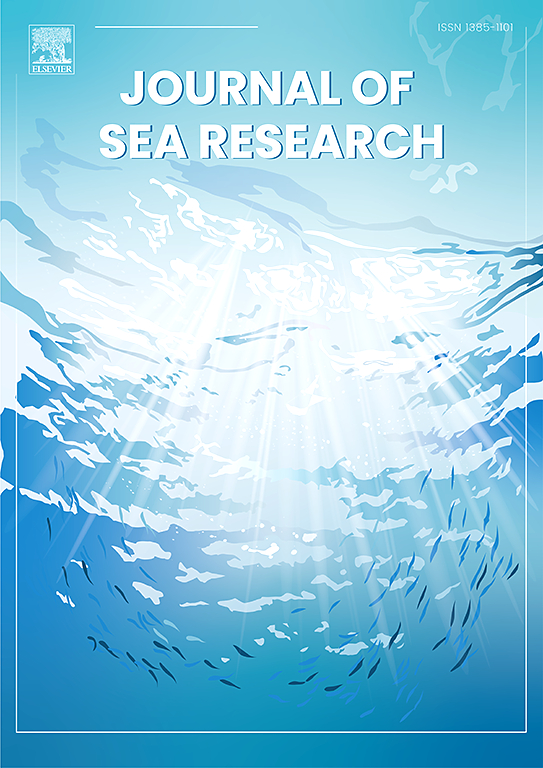Evaluation of the applicability of 28S rRNA and COI genes in the molecular identification of planktonic copepods from the Northwest Pacific
IF 2.9
4区 地球科学
Q2 MARINE & FRESHWATER BIOLOGY
引用次数: 0
Abstract
Copepods are a crucial component of marine ecosystems, serving as a primary food source for numerous marine species and playing a significant role in aquatic food webs. Traditional morphological identification methods are often challenging due to the small size and subtle morphological differences among species. Molecular identification techniques have emerged as powerful tools for species discrimination. This study evaluates the effectiveness of the nuclear 28S ribosomal RNA (28S rRNA) and mitochondrial cytochrome c oxidase I (COI) genes in identifying copepod species from the Northwest Pacific. Zooplankton samples were collected using vertical net tows from 32 stations across an area of 1,320,000 km2 in the Northwest Pacific. We analyzed sequences and conducted phylogenetic analyses on planktonic copepods. We obtained 110 valid 28S rRNA sequences from 45 species, representing 2 orders, 15 families, and 29 genera, and 62 valid COI sequences from 30 species. Notably, this study provides the first 28S rRNA and COI sequence data for Euchaeta tenuis, Euchirella indica and Scolecithricella vittata. Our findings indicate that the average interspecific genetic distances for 28S rRNA and COI are approximately 93.0 and 53.0 times higher, respectively, than the average intraspecific genetic distances, meeting the requirements for DNA barcoding. While COI-based barcodes exhibited distinct barcode gaps, 28S rRNA showed a 7 % overlap between intra- and interspecific genetic distances; however, Jeffries-Matusita (J-M) statistical test confirmed a significant gap for 28S rRNA. Compared to COI, 28S rRNA is more effective in delineating genera and higher taxonomic levels such as families revealed by phylogenetic analyses. Additionally, 28S rRNA demonstrated higher amplification success rates and comparable species-level identification performance to COI.
28S rRNA和COI基因在西北太平洋浮游桡足类分子鉴定中的适用性评价
桡足类是海洋生态系统的重要组成部分,是众多海洋物种的主要食物来源,在水生食物网中发挥着重要作用。由于桡足类个体较小,且不同物种之间存在细微的形态差异,因此传统的形态鉴定方法往往具有挑战性。分子鉴定技术已成为物种鉴别的有力工具。本研究评估了核28S核糖体RNA(28S rRNA)和线粒体细胞色素c氧化酶I(COI)基因在鉴定西北太平洋桡足类物种方面的有效性。在西北太平洋 1,320,000 平方公里区域内的 32 个站点使用垂直网拖采集浮游动物样本。我们分析了序列,并对浮游桡足类进行了系统发育分析。我们获得了来自 45 个物种(代表 2 目、15 科和 29 属)的 110 条有效 28S rRNA 序列和来自 30 个物种的 62 条有效 COI 序列。值得注意的是,本研究首次提供了 Euchaeta tenuis、Euchirella indica 和 Scolecithricella vittata 的 28S rRNA 和 COI 序列数据。研究结果表明,28S rRNA 和 COI 的平均种间遗传距离分别是平均种内遗传距离的 93.0 倍和 53.0 倍,符合 DNA 条形码的要求。基于 COI 的条形码表现出明显的条形码间隙,而 28S rRNA 的种内和种间遗传距离重叠率为 7%;然而,Jeffries-Matusita(J-M)统计检验证实 28S rRNA 存在显著的间隙。与 COI 相比,28S rRNA 在划分属和更高分类级别(如系统发育分析中揭示的科)方面更为有效。此外,28S rRNA 的扩增成功率更高,与 COI 的物种鉴定性能相当。
本文章由计算机程序翻译,如有差异,请以英文原文为准。
求助全文
约1分钟内获得全文
求助全文
来源期刊

Journal of Sea Research
地学-海洋学
CiteScore
3.20
自引率
5.00%
发文量
86
审稿时长
6-12 weeks
期刊介绍:
The Journal of Sea Research is an international and multidisciplinary periodical on marine research, with an emphasis on the functioning of marine ecosystems in coastal and shelf seas, including intertidal, estuarine and brackish environments. As several subdisciplines add to this aim, manuscripts are welcome from the fields of marine biology, marine chemistry, marine sedimentology and physical oceanography, provided they add to the understanding of ecosystem processes.
 求助内容:
求助内容: 应助结果提醒方式:
应助结果提醒方式:


